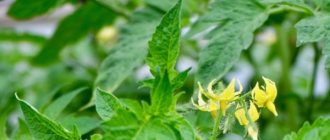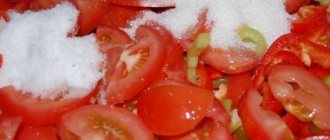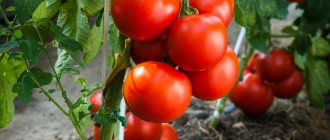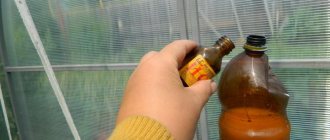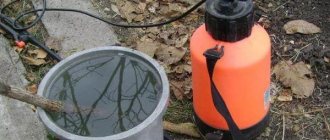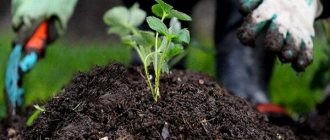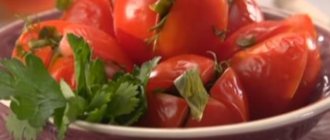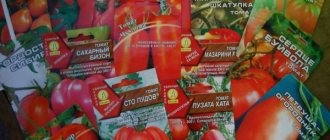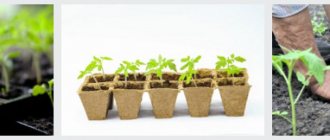Late blight is the scourge of tomatoes. This disease can completely destroy the crop. Vegetable growers use many means to combat its pathogen: from folk remedies to chemicals. Practice has shown that tomatoes can be saved with the help of an inexpensive pharmaceutical drug - Metronidazole.
How effective is treating tomatoes with Metronidazole against late blight, how often to use the drug for spraying and what nuances should be taken into account - you will learn all this from our article.
What kind of drug is this
Metronidazole is an antibacterial drug used to treat many diseases . However, this remedy has also found use in the garden due to its pronounced antifungal properties.
The principle of action in the fight against late blight
The drug contains the active ingredient metronidazole . Coming into contact with late blight, it actively affects the DNA of the pathogen cell, slows down protein synthesis and the formation of nucleic acids, which leads to the cessation of fungal reproduction.
Differences from "Trichopol"
The drug "Trichopol" is an analogue of "Metronidazole" , there are no special differences between them. It is also based on the active ingredient metronidazole. The dosage in these two drugs is also identical - 250 mg.
“Trichopol” is the trade name of the drug, and “Metronidazole” is the international nonproprietary name. In fact, these are the same medicine, just under different names. There is no difference in which tablets to use in the garden.
Efficiency
Metronidazole destroys pathogenic fungi and bacteria ; it is equally effective against most known strains. Keep in mind that fungal microorganisms have the ability to quickly adapt to drugs, so you cannot use the product regularly.
Important! The drug is a medicinal drug - it has contraindications and dosage.
Metronidazole is used in the treatment of the following diseases:
- late blight;
- brown spot;
- powdery mildew;
- Alternaria blight;
- fusarium;
- anthracnose;
- rot - white, gray, dry;
- blackleg.
Pros and cons of using
Like any other drug, Metronidazole has a number of its strengths and weaknesses .
Advantages of the drug:
- high efficiency;
- affordable price;
- ease of use;
- absence of pesticides.
Disadvantages of Metronidazole:
- the drug is not officially included in the list of products for the treatment of agricultural crops;
- promotes the development of pathogen resistance;
- the need for replacement or search for combinations with other means;
- the effect of the substance on plants has not been studied;
- the hazard class for humans has not been established.
EFFECTIVE PROCESSING OF TOMATOES FROM PHYTOPHORA. TRICHOPOLUS. Olga Chernova.
Why is trichopolum used for plants?
Gardeners are enterprising, inventive people, ready to experiment on the site in order to save the harvest. But any measures must be approached wisely and followed the recommendations, otherwise it is easy to harm the plants and get the opposite result. So it is with Trichopolum, a medicine that is part of the group of antimicrobial and antiprotozoal drugs used to treat bacterial infections.
On a note! Trichopolum (metronidazole) is not an antibiotic!
The main component of the drug is metronidazole, which blocks the synthesis of nucleic acids of microorganisms and thereby causes the death of pathogens. It is effective against a wide variety of fungi and is widely used in medicine.
Summer residents have adopted the medicine, using trichopolum against late blight on tomatoes. The disease is caused by fungi spread by zoospores. Brown or gray spots appear on the leaves, which spread to the stems, fruits, and shoots. The tablet solution successfully copes with foci of the disease and is also used as a means of prevention. But its spectrum of action is much wider, in addition to the dangerous late blight on nightshades, the drug also helps with other infections:
- powdery mildew (on cucumbers, gooseberries, roses). Causes yellowing, wilting and drying of leaves. The process of photosynthesis is disrupted, the plants gradually die;
- angular spotting (cucumbers). Necrotic spots appear on the leaves and vines of plants, which leads to the death of the tissues of the bushes and death;
- Fusarium A fungal disease in which the leaf blades of plants turn yellow, the stem becomes thinner, and rot occurs.
In addition, the specific bitter taste of the tablets, which persists in solutions, repels pests of garden crops: aphids, slugs, onion and cabbage flies.
How to prepare a solution for treatment
It is very simple to prepare the correct solution based on Metronidazole - just dissolve 20 tablets in 10 liters of water.
Gardeners recommend first making a concentrate, using warm water for dilution. As soon as the drug dissolves, the volume is adjusted to the required 10 liters. The solution cannot be stored; it must be used on the day of preparation. Rules for preparing the solution :
- the drug is diluted in water not lower than +30° C;
- To quickly dissolve, the tablets are crushed;
- the solution is ready for use 30 minutes after preparation.
Important! Increasing the dosage of the drug can lead to the death of the plant.
Many vegetable growers combine the drug with brilliant green or iodine - these products make the treatment more effective. Metronidazole acts on the fungus, brilliant green heals and disinfects damage, iodine nourishes the plant.
Thanks to such combinations, tomatoes receive double protection. First, prepare a solution with Metronidazole, then add 1 bottle of pharmaceutical brilliant green or 15-20 drops of iodine into it.
When to water tomatoes with metronidazole, mullein, manure
To reap a good harvest of tomatoes, it is necessary to feed the plant with fertilizers in a timely manner. Let's consider when to water tomatoes and how to properly fertilize with various fertilizers.
Means for watering tomatoes
Feeding with mullein
This fertilizer is widely used in gardening. Mullein for feeding tomatoes should be used during the active formation of leaves and the formation of the ovary. This fertilizer is rich in nitrogen. When feeding with manure, it is important not to burn the plants, so mullein is first diluted with water. When there is an excess of nitrogen, plants actively grow green mass, but the ovary does not form well.
Experts recommend using rotted manure for feeding tomatoes, which contains much less nitrogen than fresh manure.
You can add rotted manure to the soil during autumn digging. In this case, there is no need to apply additional fertilizers when planting tomato seedlings.
Or you can dilute 1 kg of rotted manure in 5 liters of water and apply the resulting mixture under the root of the tomatoes.
Feeding flowering tomatoes
During flowering, vegetable crops require complex fertilizers. They are easy to make using mullein as a basis. The best fertilizer for flowering tomatoes is a mixture of high concentration mullein, wood ash and superphosphate. For 5 liters of cow slurry, take 0.25 kg of ash and 0.05 kg of superphosphate. The resulting fertilizer is rich in nitrogen, potassium and phosphorus.
Another nutrient mixture is prepared from mullein, boric acid and nitrophoska. In this case, mullein diluted with water is used.
To prepare 15 liters of fertilizer you will need 10 liters of water, 0.5 kg of mullein, 1 tbsp. l. nitrophoska and ½ tsp. acids. The resulting fertilizer is rich in minerals.
It can be used not only for feeding tomatoes during the flowering period, but also for feeding seedlings.
Feeding with horse manure
Horse manure is rich in nitrogen, potassium and phosphorus. It also contains small amounts of calcium. All these microelements are needed by a growing and fruiting tomato. The quality of horse manure depends on the quality of the horse's nutrition.
It is recommended to apply horse manure during autumn digging: it improves the structure of the soil and enriches it with microelements. Apply no more than 6 kg of horse manure per 1 sq. m of land. The soil should be fertilized in this way no more than once every 2 years.
Horse manure warms the soil, so it is advisable to use it when growing tomatoes in a greenhouse. Feeding tomatoes with horse manure in a greenhouse requires following a certain procedure:
- remove the top layer of soil (at least 30 cm);
- lay a four-centimeter layer of horse manure;
- put the removed soil back in place.
Such fertilizing will not only insulate the soil, but also saturate it with microelements necessary for the development of vegetable crops.
With the help of manure, heavy soils can be made light.
Root feeding of tomatoes
Root feeding is done 3 times per season
Root feeding with horse manure can be done 2-3 times per season. The simplest option for root feeding is an infusion of manure. 0.5 kg of horse excrement is diluted in 8 liters of water and everything is thoroughly mixed. The mixture is left to infuse for 7 days.
Rotted manure is also suitable for root feeding. In the area where the root system of the vegetable crop is located, remove a small layer of soil, put rotted manure there, cover it with soil and water it with water. In the northern regions of the country, warm beds are made using horse manure.
Treatment with metronidazole
If you need to water a vegetable crop with manure to feed it, then metronidazole will help get rid of late blight. This product is non-toxic, which allows it to be used even during the fruiting period.
If the disease has already affected the beds, before spraying the tomatoes, get rid of all the affected leaves, after which they spray with metronidazole diluted in water.
To prepare 10 liters of solution you will need 15 tablets of the drug.
It is advisable to carry out preventive treatments of plantings with metronidazole. The first spraying occurs in June. Since the drug is non-toxic, it can be used to treat not only tomatoes, but also other crops growing nearby. If the plants do not show signs of a fungal disease, re-treat them with metronidazole 14 days before harvest.
If rot appears on the leaves, the plantings are treated daily. You need to spray the beds with a solution, when preparing it, take 1 tablet of the drug for each liter of water. You need to spray the leaf plates on both sides.
An alternative to metronidazole is trichopolum. Trichopolum solution is prepared by analogy with metronidazole solution.
Treatment with metronidazole does not affect the taste of tomatoes.
Feeding with chicken manure
Chicken manure is also used as fertilizer. It contains phosphorus, nitrogen, potassium and magnesium. Chicken manure can be used to enrich tomatoes with microelements in several variations.
The fastest way to prepare liquid fertilizer. For 20 liters of water take 1 kg of chicken manure. Mix everything thoroughly and leave for 10 days. Plants are watered with this solution several times a season.
The first time liquid fertilizer is applied 20-25 days after planting the seedlings in a permanent place. The second time - 30 days after the first. Watering is carried out between the rows.
This product is quite concentrated and can burn the roots of tomatoes.
It will take 3-4 months to prepare compost. The droppings are spread on grass or green tops of vegetable crops, soil is added, and everything is mixed thoroughly.
All components are taken in approximately equal quantities. It is best to fertilize the beds with compost in early spring, so it is advisable to prepare it in the fall: the droppings will rot over the winter.
Compost is placed between the beds. If you add straw to it, you get mulch.
Treatment with potassium monophosphate
You can prepare the fertilizer mixture yourself
Monopotassium phosphate is used if tomatoes grow poorly or the ovary is poorly formed. This is a mineral fertilizer that consists of 52% phosphate and 33% potassium. The remaining 15% is other minerals. You can use the drug yourself or prepare nutritional mixtures.
To prepare 10 liters of solution you will need 15 g of powder. Water the tomato leaves with this solution. Repeated treatment is carried out after 14 days. Potassium monophosphate cannot be used more than 2 times in one season.
There are no specific dates for adding potassium monophosphate. It is added when necessary to stimulate the flowering of vegetable crops. The drug also increases the resistance of plants to various diseases, but it is not worth treating: it is suitable exclusively for prevention.
Fertilizing with onion peels
Onion peels contain antimicrobial substances, vitamins, quarcetin and ascorbic acid. The use of onion peel products is justified at any stage of vegetable cultivation. In addition, such funds have low cost.
You can prepare an infusion or decoction from onion peelings. To prepare a decoction, place the peelings in a container of water, bring them to a boil and boil for 5-7 minutes, then remove the pan from the heat and cool the decoction. It is best to prepare onion broth in an enamel bowl.
To prepare the infusion, pour boiling water over the purifications and leave for 48 hours. The ratio of purifications to water should be 1:2. Before use, the onion infusion is diluted with water in a ratio of 1:3.
The frequency of watering the beds with products made from onion peels can be 3-4 times a week.
You can also use onion products to treat tomatoes: they are effective in controlling pests. But before spraying the tomatoes, add crushed soap to the infusion or decoction and wait until it dissolves.
Onion products are also used to disinfect soil.
Folk remedies
- Brazhka. You can compensate for the lack of microelements with the help of yeast, from which the mash is prepared. To prepare it, take 10 liters of water and 2 kg of fresh yeast. Before feeding, the mash is diluted with clean water. For 1 part of mash there should be 10 parts of water. The product is used if the seedlings grow poorly.
- Bread. Brown bread is also used to prepare the nutrient solution. To do this, it is cut into small cubes and dried in the oven, then placed in a bucket and filled with warm water. Next, press down the crackers with a weight and leave for 7 days in a dark place, then drain the water and add 2-3 liters of fresh water. This solution should be fed to young seedlings that have already produced 5-6 leaves.
- Beer. By diluting beer with water in a ratio of 1:10, you can get a good growth stimulator.
- Kefir. This fermented milk drink, diluted with water in a ratio of 1:7, is used for the prevention and treatment of late blight. Even against late blight, sediments are treated with saline solution.
- Urine. This product helps increase productivity. You can use fresh urine, but experts recommend giving preference to a fermented product. Urine, undiluted with water, is added to the soil.
- Ammonia solution (ammonia). This product is used for nitrogen starvation of vegetable crops. To prepare 10 liters of solution you will need 20-25 ml of ammonia. Its use is justified if tomatoes grow poorly.
Store-bought drugs
During the period of active growth and formation of the ovary, it is advisable to feed the vegetable crop with potassium humate. Fertilizer is used as root feeding. It is diluted in accordance with the instructions indicated on the package.
FEEDING TOMATOES. HOW TO FEED TOMATO SEEDLINGS! CORRECT WATERING OF TOMATOES IS VERY IMPORTANT! HOW AND WHEN TO WATER TOMATOES. The best FEEDINGS FOR SEEDLINGS of tomatoes, peppers, eggplants. Feeding tomatoes. What, when and how to feed (fertilize) tomatoes? Part 1How to fertilize tomatoes, feeding tomatoesHow to water tomatoes and cucumbers in a greenhouse
The store-bought drug Baikal EM1 gives good results. This is a growth stimulant that is most effective when growing vegetables in greenhouses.
Strong seedlings are obtained in coconut substrate. When using it, you do not need to put anything additional into the hole when planting seeds. You won’t have to fertilize the soil while growing tomatoes.
Source: https://FermoVed.ru/pomidoryi/kogda-polivat-metronidazolom-korovyakom-navozom.html
How to treat tomatoes with Metronidazole
You can treat tomatoes with the drug at the stage of sowing seeds - this will protect the seedlings not only from late blight, but also other fungal diseases. To do this, the seeds are soaked in the prepared solution for 30 minutes, then they are dried and planted in a planting box.
Step-by-step instruction
The drug is most often used for spraying:
- Prepare the solution.
- Spraying is carried out in the first half of a dry, windless day.
- For the procedure, a fine spray is used.
- Process the stem and leaves on both sides, paying special attention to the lower branches.
- Additionally, water the seedlings at the root with the solution - 50 ml per bush.
- If precipitation occurs after spraying, the procedure must be repeated.
Important! When working with metronidazole, you must use personal protective equipment - a mask and gloves. It is not recommended to stay in the greenhouse for a long time after treatment.
Processing times and frequency
Spraying with Metronidazole is carried out no more than 3 times a season:
- the first spraying after planting seedlings in the garden bed;
- the procedure is repeated 2 weeks before the start of harvest;
- if there are no signs of disease, then there is no need for treatment.
Gardeners do not recommend using the drug to treat tomatoes 2 weeks before harvest . Despite the fact that the hazard class for humans of the drug has not been established, to protect health it is better not to shorten the waiting period.
Basic processing rules
To achieve high efficiency when spraying with trichopolum, you must adhere to certain rules:
- alternation with other drugs to avoid the fungus developing immunity to metronidazole;
- if it rains after treatment, it must be repeated the next day;
- the solution is diluted before use;
- processing is carried out in the first half of the day, when the weather is sunny and windless;
- Process the lower stems and leaves more thoroughly;
- It is imperative to follow the dosage, otherwise the plants will receive a chemical burn.
Use for prevention and treatment
Metronidazole is used not only for treatment, but also for prevention purposes . It should be used by those who have already encountered diseases on their property last season.
Preventive measures begin even before planting seedlings . An undiluted tablet of the drug is added to each well. As soon as the plant is established, the beds are treated once every 10 days. The following solution is used: 5 tablets of water are dissolved in 10 liters of water. Spraying with the drug can be alternated with other drugs and folk remedies.
Important! In the garden, a tablet dosage of 250 mg is used.
At the first appearance of late blight symptoms, treatment is carried out every day . A stronger solution is used - 20 tablets per 10 liters of water. You can spray the bush, apply the solution under the bush, or carry out spot treatment of damage.
Phytophthora in tomatoes: what it looks like, favorable conditions for the fungus
Late blight disease is caused by a fungus. The spores are found in the soil, as well as in low-quality seeds. Plants can also become infected with the help of wind, which carries pathogens from nearby plantings or a neighbor’s plot. Late blight requires emergency intervention, since a week after its detection there is a high probability of losing the entire crop.
How the disease manifests itself: first, dark brown spots form on the bushes - you need to look for them on the lower part of the leaf blade. The fungus then progresses, moving to the stem and fruits. If late blight has developed to this stage, then the plantings will have to be removed and burned; it will no longer be possible to cure them.
What conditions allow the late blight fungus to develop and infect tomatoes:
- Density of plantings. Such bushes receive little light necessary to kill the fungus. When planting, a distance of at least 0.7-1 m must be maintained between tomatoes. And we should not forget about thinning out the stepchildren.
- High humidity. Water should be added as needed in moderate quantities. Drops should not fall on the leaves - pour water strictly at the root. Excessively moist soil should be loosened after watering.
- Weak root system. This mistake should be avoided already at the seedling stage. The roots are fed with complex fertilizers. When transplanting, tomatoes are moved along with a lump of earth, trying not to damage the roots.
- Overfeeding with nitrogen. This “fatification” leads to a weakening of the plant’s immunity: tomatoes require the element only at the green growth stage.
Reviews from vegetable growers
There is no clear opinion from experts about whether Metronidazole should be used on the site . However, more and more gardeners, having tried this cheap pharmaceutical product, are replacing pesticides with it.
Irina, Armavir : “From friends I heard about the effect of Metronidazole against late blight. At first, I was afraid to use it on the site, because it is a “human” medicine. I decided to try it anyway and was not disappointed. I am very pleased with the result - despite the rainy summer there was no late blight on the tomatoes. Next season I want to try combining metronidazole with brilliant green.”
Ruslan, Moscow region : “I treat the beds with Metronidazole, add iodine to the solution - this is additional nutrition for tomatoes. This season I want to try seed treatment with the drug.”
Galina, Saratov : “The drug did not save my tomatoes from late blight. I planted tall varieties, regularly treated them with a solution, and repeated the procedure after rain. I had to uproot the bushes and burn them. The fungus probably adapted to the medicine.”
When should I start using it?
When the first signs of late blight infection appear, it’s time to start processing. You can't miss deadlines.
Symptoms of pathology:
- the formation of dark brown spots on tomatoes;
- yellowness and darkening of inflorescences;
- damage to the leaves, the appearance of grayish inclusions on the leaf blades;
- the appearance of dark marks and spots on the shoots.
The initial signs are brown spots. If you miss the disease, it quickly goes into full swing, when you have to use systemic fungicides.
Prevention of late blight
Bushes need to provide the following conditions:
Late blight is a dangerous disease that quickly kills tomato bushes. Therefore, it is advised to thin out the bushes, remove shoots, water and ventilate them properly. If several bushes are sick with late blight, then cut off all the diseased parts. If the disease has spread, the bushes need to be pulled out and burned. You can trim diseased and healthy leaves only at low air humidity.
You cannot treat the plants with solutions or water them after cutting off the diseased parts, since after cutting off the leaves, wounds remain and they can become infected. After pruning, you need to leave the plants for 3-4 hours so that the wounds heal a little, only after that you can treat the plants with solutions.
Attention! When using Metronidazole for tomatoes against late blight, you need to remember that this is a medicine, it has contraindications and dosage. Therefore, do not use more tablets than necessary, and do not process tomatoes more than 3 times during the growing season.
You cannot cure tomatoes from late blight, but you can slow down the disease. Because of this, it is necessary to take preventive measures against the disease.
Safety precautions when working with the product
Trichopolum does not belong to the group of toxic chemicals and therefore its use is conditionally safe. There is no need to take special precautions when working with the drug.
For a more effective effect on pathogens, some experienced gardeners advise using the drug together with antiseptics - brilliant green or iodine. In this case, additional disinfection of the soil and shoots occurs.
Add 1 bottle of brilliant green or 15 drops of iodine to the prepared solution of the drug.
Iodine and brilliant green together with trichopolum for comprehensive disease control
Saving the crop from death: Trichopolum from late blight on tomatoes
Trichopolum has firmly entered the arsenal of gardeners as a means to combat late blight. It is used separately and in combination.
Description of the drug
Trichopolum is a classic medicine that is used in medicine to treat a wide range of diseases. These are giardiasis, trichomoniasis, infection of the oral mucosa and bacterial infections. The main component is metronidazole. Auxiliary ingredients:
- starch,
- syrup,
- magnesium stearate.
This composition made the drug effective in the fight against fungal, viral and bacterial pathogens.
In the tomato world it gives a positive result against late blight.
Among the undisputed bonuses:
- harmlessness;
- the ability to use fruits for food even after irrigation;
- effectiveness against powdery mildew and fusarium;
- no need for chemicals.
When should I start using it?
When the first signs of late blight infection appear, it’s time to start processing. You can't miss deadlines.
Symptoms of pathology:
- the formation of dark brown spots on tomatoes;
- yellowness and darkening of inflorescences;
- damage to the leaves, the appearance of grayish inclusions on the leaf blades;
- the appearance of dark marks and spots on the shoots.
The initial signs are brown spots. If you miss the disease, it quickly goes into full swing, when you have to use systemic fungicides.
How to prepare the solution?
Metronidazole for tomatoes against late blight - how many tablets do you need to fight the fungus? In the traditional version, 20 tablets are taken. Powder until a homogeneous fine mixture is obtained.
How can you dilute Trichopolum from late blight on tomatoes:
- Powder substrate from 20 tablets is poured into a container with water.
- Stir until dissolved.
- Pour into a bucket with 10 liters of water, stir thoroughly.
- Leave to brew for 20-30 minutes.
Recipes with Trichopolum for late blight:
- Classical. Only 20 medicine tablets and water.
- With Zelenka . For 1 bucket of water, 1 package of the drug and 1 bottle of brilliant green.
- With iodine . 20 tablets and 1 jar of Lugol’s alcohol solution are dissolved in 10 liters.
To enhance the effect, additional recipes are used, which are introduced for the purpose of alternation:
- Garlic-kefir tincture . 2 heads are crushed with a knife or tinder on a grater. Pour in 1 liter of kefir. Mix and dilute in 10 liters of water.
- Serum-iodine solution . Mix 1 liter of whey, 20-25 drops of iodine. Add water to a 10-liter bucket.
Treatment of diseased tomatoes
Treatment of tomatoes with metronidazole against late blight is carried out using a foliar method. To properly prepare the solution, purchase 2 blisters of Trichopolum or an available analogue at the pharmacy. Dissolve in 1 bucket of water. First, prepare a concentrated solution. Then pour it into 10 liters of water, obtaining the optimal concentration.
When irrigating, it is important to consider that fungi are hidden as much as possible on the lower surface of the plates. Spraying is carried out especially carefully from below. To neutralize the roots, you need to water and treat the bushes well. The dose of solution per plant that can be sprayed is about 50 ml.
Treatment of tomatoes against late blight in open ground with Trichopolum is carried out once every 10-12 days. At the same time spray with additional means.
A similar procedure in the greenhouse is carried out 2 times for the purpose of prevention:
- 10-14 days after transplanting to the beds;
- on the eve of harvest.
To combat the pathogen at the height of the disease, irrigation is carried out daily or every other day until the signs of pathology disappear. Does Trichopolum kill late blight on tomatoes? The drug acts on the principle of fungicides, stopping dangerous infections.
According to reviews and results, the drug:
- completely justifies itself;
- effective in the initial stages;
- the disease stops quickly.
Advantages and disadvantages
Among the advantages:
- ease of solution preparation and irrigation;
- affordable prices;
- efficiency;
- safety for human health.
Of the minuses:
- rapid adaptability of pathogens;
- the hazard class has not been established;
- not included in the State Register of permitted means for processing;
- There are no complete studies on the effects on multicellular organisms.
Safety precautions when working with the product
The drug is not poisonous. Processing is carried out without observing strict measures and wearing protective equipment.
Compatibility with other drugs
The effect is enhanced when combined with antiseptics - brilliant green or iodine. Joint treatment is useful for disinfecting soil and bushes at the same time.
Storage conditions and shelf life
The drug is stored for up to 5 years. Keep in the dark in a dry place. It is advisable that the temperature does not exceed 25 degrees.
The prepared solution is used fresh. Do not keep for more than 5 hours.
Can it be replaced with other means?
There are many other proven compounds against late blight:
- "Fitosporin"
- "Fundazol"
- "Quadris"
- "Ridomil".
Among copper preparations, Bordeaux mixture has proven itself well.
Trichopolum is especially recommended for initial signs of infection. Then it is possible to cope with the disease without using additional chemicals.
Source: https://repka.online/ovoshhi/tomaty/bolezni/trihopol-ot-fitoftoryi.html
